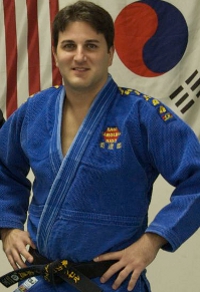Seoinage, What Does It Mean?
by Jason Russell
If you have been around judo long enough the phrase "he/she is a seoi-nage specialist" or
"my favorite technique is seoi-nage" has been heard. Phrases like this can be confusing to
new students of judo. Seoi-nage means shoulder throw, but there are many types of shoulder throws, such
as morote seoi-nage, ippon seoi-nage, ippon seoi otoshi and ippon seoi-nage makikomi. Seotoshi is another
term that is loosely used to describe a variation of seoi-nage, but it too has many variations. It is
important as coaches that we distinguish these variations to new students. When coaches generalize a
technique like seoi-nage or seotoshi it implies that the techniques are the same. Although the variations
of seoi-nage are similar in fashion, they are unique throws all to themselves with a wide variety of entries
and angle of attack. To confuse beginners even more is seoi-nage’s name, shoulder throw, which beginners
often

interpret as meaning that the uke’s arm should be placed on the tori’s shoulder, which is incorrect.
Throughout this series we will be discussing variations of seoi-nage, which will include pictures of variations
and tips to improve your technique.
Instructors contributing to our website will offer various methods of executing judo techniques that have been successful for them or their students. Judo techniques have an endless array of entries and execution and it is our hope that the website will proved informative instruction on a variety of techniques. Always consult with your instructor before trying new techniques that you learned on this website.
If you would like to contribute a technique or coaching tip to the NCJI website please email Jason Russell at jrussell126@gmail.com. This can either be submitted in a page format or by video.
Below are two variations of ippon seoi-nage, known as ippon soei-otoshi.
Picture 1 (ippon seoi-otoshi: standing version-leg block)
The key point of this throw is the placement of your foot. Unlike other versions of standing ippon seoi-otoshi you will not place your toes or the bottom of your foot on the mat. Your foot is turned inward and you will collapse on the side of your foot. This inward turn of the foot makes for a powerful turning motion, which is vital in order for the throw to work. After you have entered the throw, you simply collapse on the blocking leg and the force of the throw will bring your opponent over.
Picture 2 (ippon seoi-otoshi: drop version single knee)
The best time to attack with this version of ippon seoi-nage is when your opponent is stepping forward with their right leg. As your opponent steps or is pulled forward, you drop low and pull down and across your body. To ensure that your opponent lands on their back you will continue to roll through the throw until you are facing the ceiling. This ensures that your back is pressed against your opponent chest and landing them securely on their back.
This variation can also be executed with the leg positioned inside your opponent’s legs and applying the same principles.

